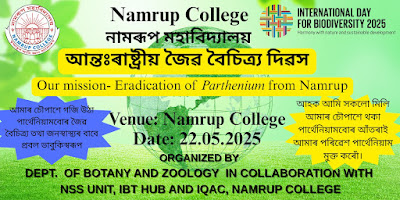Namrup College marked the International Day for
Biodiversity on 22nd May 2025 with the theme "Harmony
with Nature and Sustainable Development." The event was a
collaborative effort by the Department of Botany and Zoology, NSS Unit,
Institutional Biotech Hub, and IQAC of Namrup College. The primary objective
was to raise awareness about the urgent need for conservation of indigenous
species and local biodiversity, emphasizing the power of community
participation in achieving these goals.Focus on Invasive Species:
Parthenium hysterophorous
The programme centered on the alarming spread of the
invasive alien plant species Parthenium hysterophorous in Namrup and its
surrounding areas over the past 2-3 years. Recognized globally as one of the
most threatening weeds to local biodiversity, Parthenium poses severe
risks not only to native flora and fauna but also to human and animal health.
Its rapid proliferation has become a pressing concern for the region.
Programme Highlights
Inaugural Session:
Dr. Durga Prasad Gogoi, Principal of Namrup College,
inaugurated the programme, emphasizing the plant's fatality and its global
impact on biodiversity and public health. He announced the college’s commitment
to a sustained, yearwise eradication campaign, calling for collaboration with
local government organizations.
Dr. Jayanta Sonowal, Head and Assistant Professor of Botany,
delivered an insightful speech outlining the significance of Biodiversity Day,
sharing recent statistical trends, and highlighting the grave consequences of
Parthenium invasion.
Community Engagement
Students and faculty, particularly NSS volunteers,
participated in hands-on eradication of Parthenium from roadsides in the
vicinity. The event included the distribution of informative leaflets detailing
the plant’s negative impacts and management strategies, thereby empowering the
community with knowledge and practical solutions.
Awareness and Outreach:
The activities and outcomes were widely publicized on social media platforms,
amplifying the message and encouraging broader community involvement in the
fight against invasive species.
Outcomes and Future Directions
The observance was highly successful in fostering
understanding of the dangers posed by Parthenium and the broader importance of
biodiversity conservation. Participants left with a renewed sense of
responsibility and practical experience in environmental stewardship. Namrup
College’s commitment to a structured, yearwise eradication
programme—integrating government bodies and sustained public awareness—sets a
strong precedent for regional biodiversity management.
Conclusion
The International Day for Biodiversity at Namrup College was
not just a ceremonial observance but a catalyst for meaningful action against
one of the most pressing ecological threats in the area. By uniting academic
leadership, student activism, and community outreach, the event exemplified how
educational institutions can drive impactful change for a sustainable and
harmonious future with nature.
Event photo/video gallery
